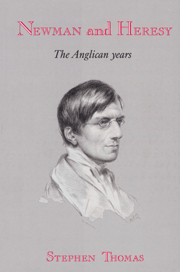Book contents
- Frontmatter
- Contents
- Acknowledgments
- A short glossary of heresies
- Introduction
- PART ONE DEFENCE: ARIANISM AND THE CHURCH–STATE CRISIS
- PART TWO ATTACK: SABELLIANISM AND APOLLINARIANISM – LIBERALISM UNMASKED.
- 5 New directions: the mid-1830s
- 6 Patristic research: the edition of Dionysius of Alexandria
- 7 The Hampden Controversy
- 8 Blanco White
- 9 Apollinarianism
- 10 Tract 73: On the Introduction of Rationalist Principles into Revealed Religion
- 11 The Elucidations on Hampden
- 12 Apollinarianism revisited
- 13 Sabellianism revisited
- 14 Heresy, typology and the encodement of experience
- PART THREE RETREAT AND REALIGNMENT: MONOPHYSITISM AND THE COLLAPSE OF THE ‘VIA MEDIA’
- Conclusion
- Notes
- Bibliography
- Index
11 - The Elucidations on Hampden
Published online by Cambridge University Press: 23 November 2009
- Frontmatter
- Contents
- Acknowledgments
- A short glossary of heresies
- Introduction
- PART ONE DEFENCE: ARIANISM AND THE CHURCH–STATE CRISIS
- PART TWO ATTACK: SABELLIANISM AND APOLLINARIANISM – LIBERALISM UNMASKED.
- 5 New directions: the mid-1830s
- 6 Patristic research: the edition of Dionysius of Alexandria
- 7 The Hampden Controversy
- 8 Blanco White
- 9 Apollinarianism
- 10 Tract 73: On the Introduction of Rationalist Principles into Revealed Religion
- 11 The Elucidations on Hampden
- 12 Apollinarianism revisited
- 13 Sabellianism revisited
- 14 Heresy, typology and the encodement of experience
- PART THREE RETREAT AND REALIGNMENT: MONOPHYSITISM AND THE COLLAPSE OF THE ‘VIA MEDIA’
- Conclusion
- Notes
- Bibliography
- Index
Summary
The inception of the process leading to the evolution of this idea of ‘Sabellianism’ was, it will be remembered, the controversy surrounding Hampden about Oxford matriculation. Only a week after Newman had completed the ‘Postscript’, he again returned to the subject of Hampden, when the controversy moved into a second phase. On 8 February 1836, it became known that Hampden's name had been put forward to the King for the Regius Professorship. There was just time for a last improvised protest to avert Hampden's occupation of the Chair. Newman made his contribution on the night of Wednesday, 10th February, he ‘sat up all night at pamphlet against Hampden’. The Elucidations had, in fact, a limited function: to demonstrate overwhelmingly, from Hampden's own works, that the professorial nominee's theology was indistinguishable from Socinianism – and to do so with the minimum of comment, so that the pamphlet might act as a reference-work, providing quotable ammunition at a moment's notice. He demands: ‘Now, supposing hearers of his were to take up with Socinianism would he be earnest in reclaiming them or not?’
Hampden's theology of revelation-as-facts could easily be made to fall into Newman's category of ‘Sabellian’. Was not the controversy over the Regius Professorship a further opportunity for Newman to deploy this critique, especially since it was fresh in his mind from the ‘Postscript’ written only a week or so earlier? Yet there is not a single reference in Elucidations to Sabellianism.
One possible explanation may lie in the function of the pamphlet: Sabellianism as Newman uses it, is a complex, subtle, many-sided and, indeed, sometimes elusive concept.
- Type
- Chapter
- Information
- Newman and HeresyThe Anglican Years, pp. 140 - 141Publisher: Cambridge University PressPrint publication year: 1991

